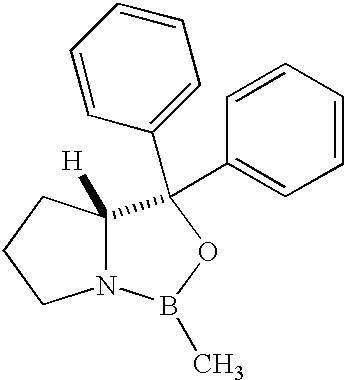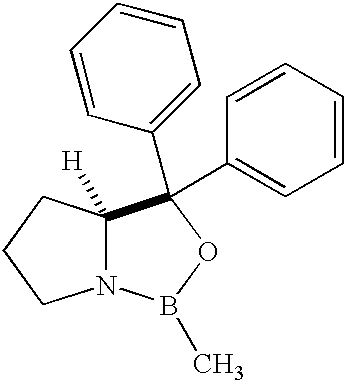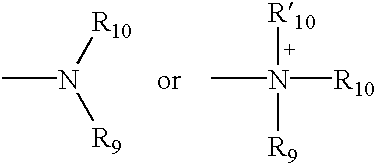Methods for the stereoselective synthesis of substituted piperidines
a technology of substituted piperidines and stereoselective synthesis, applied in the field of stereoselective synthesis of substituted piperidines, can solve the problems of pain and its many manifestations, poor treatment of signs of tissue damage, and serious underestimate of the effect of pain
- Summary
- Abstract
- Description
- Claims
- Application Information
AI Technical Summary
Problems solved by technology
Method used
Image
Examples
example 2
[0275] Synthesis of (3S)-Piperidine-1,3-dicarboxylic acid 1-benzyl ester 3-ethyl ester (10) 33
[0276] A 1.0 L round-bottom flask was charged with K.sub.2CO.sub.3 (29.2 g; 171 mmol), piperidine (50 g; 163 mmol), and a 1:1 mixture of THF / H.sub.2O (800 mL). A 150 mL addition funnel was placed on the flask and charged with CbzCl (29.2 g, 171 mmol). The flask was cooled to 0.degree. C. and then CbzCl was added dropwise over 5 minutes. The reaction mixture was warmed to 20.degree. C. and stirred for 1 h. The reaction mixture was extracted with EtOAc (500 mL) and the organic layer was washed with water (500 mL), saturated NaCl (500 mL), dried (MgSO.sub.4), filtered and concentrated in vacuo. The crude material (49.3 g, 100% yield) was carried on without further purification.
example 3
[0277] Synthesis of 3-hydroxymethyl-piperidine-1-carboxylic acid benzyl ester (8) 34
[0278] Piperidine-1,3-dicarboxylic acid 1-benzyl ester 3-ethyl ester (7) (1.5 g, 5.83 mmol) was dissolved in 5.8 mL of anhydrous THF, and the reaction was stirred under N.sub.2 at -5.degree. C. while lithium aluminum hydride dissolved in THF (7.0 mL, 1.0M) was added dropwise by addition funnel over 30 minutes. When the reaction was complete by TLC (10 min.), H.sub.2O (0.6 mL), then 10% NaOH (1.5 mL), then H.sub.2O (0.6 mL) were added, and the reaction was stirred for about 45 minutes. The salts were removed by filtration and the solution was dried with sodium sulfate, filtered, and concentrated. The crude material was purified using an ISCO CombiFlash flash column (silica, 80:20 Hexane: EtOAc to 40:60 Hexane: EtOAc) to achieve 1.24 g of pure 8 (66% yield).
example 4
[0279] Synthesis of (3R)-Piperidine-1,3-dicarboxylic acid 1-benzyl ester (25) 35
[0280] A 1.0 L round-bottom flask was charged with ester (163 mmol), THF (360 mL), MeOH (120 mL), and water (120 mL). The flask was cooled to 0.degree. C. and a solution of LiOH (1.0 M in water; 325 mL; 325 mmol) was added slowly dropwise. The reaction was stirred overnight at 0.degree. C. and then quenched with 10% HCl slowly dropwise at 0.degree. C. until the pH.about.3. The mixture was extracted with EtOAc (500 mL), washed with water (500 mL), saturated NaCl (500 mL), dried (Na.sub.2SO.sub.4), filtered and concentrated in vacuo. The crude material (40.5 g, 95% yield) was carried on without further purification.
PUM
 Login to View More
Login to View More Abstract
Description
Claims
Application Information
 Login to View More
Login to View More - R&D
- Intellectual Property
- Life Sciences
- Materials
- Tech Scout
- Unparalleled Data Quality
- Higher Quality Content
- 60% Fewer Hallucinations
Browse by: Latest US Patents, China's latest patents, Technical Efficacy Thesaurus, Application Domain, Technology Topic, Popular Technical Reports.
© 2025 PatSnap. All rights reserved.Legal|Privacy policy|Modern Slavery Act Transparency Statement|Sitemap|About US| Contact US: help@patsnap.com



